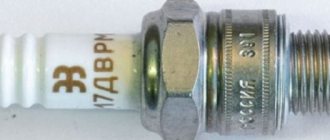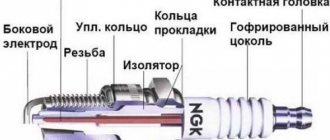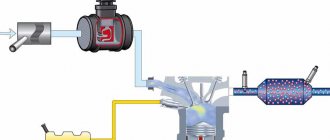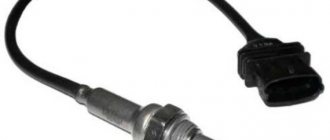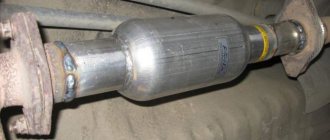Traditionally for the AvtoVAZ family, the 2112 series was equipped with a whole set of engines with various options for ECU controllers. It is the version of this unit that determines which mass air flow sensor is installed on a particular VAZ 2112.
There are compatibility tables for electronic engine control units and flow meter models.
Mass air flow sensors are produced by various manufacturers: BOSCH, Siemens, Itelma, Avtel, etc. There is no fundamental difference between the brands, although drivers intuitively gravitate towards German products. Regardless of the logo on the device, the compatibility index is the same. Knowing the factory classification of the engine and the version of the ECU controller, you can always select a replacement mass air flow sensor.
For example, your VAZ 2112 is equipped with a 16 valve engine 21124 with a power of 90 l/s, with an environmental standard of Euro 3. The ECU controller on such an engine is BOSCH M7 9.7. According to the table, it corresponds to a flow meter with the index 0 280 218 116, the popular name is “one hundred and sixteenth”.
Information: some car enthusiasts claim that this index means compatibility only with 1.6 liter engines. This is an incorrect statement: the factory MAF classifier has no relation to the volume of the internal combustion engine.
What is a DMRV?
This device is very necessary in order to determine the volume of air that fills the combustion chambers when the engine is running. The sensor is usually installed after the air filter in the power system.
When driving, the automobile power unit is supplied with 1 volume of fuel, as well as 14 equal parts of air. This prepares the correct fuel-air mixture. This is the key to proper operation of the motor in the most optimal modes for it.
For any violation of this ratio, the car owner will observe either increased fuel consumption, or a decrease in the power of the power unit, or both. If you know the signs of a malfunction of the mass air flow sensor, it is easy to identify a breakdown of the device.
The mass air flow sensor is necessary in order to accurately measure the required amount of air. This amount is calculated in the sensor itself and then sent to the ECU, where, based on these data, the required amount of fuel will be calculated.
The more the driver presses the accelerator pedal, the more air enters the combustion chambers. The sensor records the amount and sends a special command to the ECU to increase the volume of injected fuel. If the car is to run or drive more smoothly, then a small amount of air will be needed.
This is why you need a mass air flow sensor. It measures the required volumes of air for engine operation with maximum accuracy.
System depressurization
If depressurization occurs in the intake tract system, then instability in engine operation occurs. Air leaks occur in the following parts of the car:
- In sealed areas of the nozzle;
- On exhaust systems for gasoline vapors;
- On the walls of the throttle frame;
- On idle jets;
- On the vacuum brake booster pipes;
- On the cleaning pipes.
Due to improper air removal, improper mixing of fuel masses occurs. Emergency symptoms are detected during the operation of the intake tract. The air leaving the system does not pass through the filtration system. It contains many harmful particles of dirt, metal, and plastic, which enter the engine and threaten to lead to poor performance of the latter.
How does the MAF work?
This device is a small wire made of platinum alloy. The size of this cord is only 70 microns. It is installed in a special tube, which is located in front of the throttle valve.
This wire is cooled under the air flow. To regulate the temperature between it and the air flow, electricity is applied to the wire. The charge level can be adjusted. The more the wire is blown, the more electricity is supplied.
Due to constant use, this wire is constantly covered in dirt. But modern sensors have a self-cleaning system. Dirt is one of the reasons why the device fails, but there are other signs of a malfunction of the MAF sensor.
Although the design of the device is as simple and reliable as possible, it also fails. Its only drawback is that it is not suitable for repair. If the sensor fails, it is simply replaced with a new one.
Cleaning the sensor
Oxygen sensor on a 16-valve VAZ-2112 engine: signs of a malfunction
In some cases, it is possible not to flush the VAZ 2110 DMV, but to replace it. But many people don’t know how to clean the DMV VAZ.
These procedures are easy to do yourself:
- first you need to disconnect the pipe from the mass air flow sensor;
- then the sensor itself is removed, this is necessary for better flushing of the DMV VAZ2110;
- to remove the sensor, use a special key with asterisks;
- unscrew the fastening systems and remove the sensor from the pipe and inspect its appearance;
- in some cases, an oil deposit forms on the sensor, but after cleaning the sensor will be as good as new;
- to clean the sensor you need to purchase a special carburetor cleaner;
- There is a film inside the sensor, and there are thin wires on it, and in order not to damage them, you should carefully spray them with the product;
- leave for a while to allow the sensor to dry; it is best to use the product in cans;
- Some people use alcohol to clean the sensor; it will also clean it well;
- Also, when cleaning the sensor, do not forget about cleaning the pipe from accumulated dirt and dust;
- After cleaning, allow the parts to dry and then reassemble in the reverse order.
And after such measures are taken, the sensor can function and continue to work. But in some cases it is still worth replacing the sensor.
There are several price categories for the mass air flow sensor:
- Low cost, most often these are Chinese-made parts, and their cost does not exceed 1000 rubles, but experts do not recommend purchasing cheap sensor options.
- Average cost, most often these are AvtoVAZ parts, which can be of domestic or foreign production, their cost ranges from 1500-2500 rubles.
- It is best to purchase more expensive sensors, they are of high quality and reliable, but the cost here can be higher than 5,500 rubles, and they have a long service life.
When choosing, you should pay attention not only to the cost of the sensor, but you also need to take into account the manufacturer, and it is better to choose foreign manufacturers. They are usually of average cost and good quality
The second way is using a multimeter
Before performing these diagnostics, it should be noted that this will only work with a Bosch mass air flow sensor. Before performing the test, set the limit on your multimeter to 2 V, and then switch the device to constant voltage operation.
Turn on the ignition and connect the red wire to the yellow one on the block. Connect the black wire to the green one. At this moment the engine should not be running. Measure the voltage If the reading is between 1.01 and 1.02 then everything is fine. The multimeter shows voltage up to 1.03 - there is nothing to worry about, this is acceptable. The limit level is 1.05. If it is higher, then you can again look for the cause of the breakdown.
External signs of a malfunction of the VAZ 2110 mass air flow sensor
This is the third way to diagnose the sensor. To determine its serviceability, carefully inspect the internal cavities of the air pipe where the mass air flow sensor is mounted. In order to do this, you will need a shaped screwdriver. Loosen the clamp and disconnect the corrugated pipe. The surface of the corrugation should be as dry as possible, without an oil film.
It should be noted that the main signs of a malfunction of the mass air flow sensor are dirt on the working surface. It is formed due to the fact that the air filter was not replaced in time. Oil deposits will tell the driver that the oil level in the lubrication system is high or that the oil cutter is not working properly. With these signs, the sensor may still work, but will soon fail.
Next you need to completely remove the mass air flow sensor. You will find signs of a malfunction after a visual inspection of the device. To carry out this operation you will need a 10 key.
Unscrew the two screws and remove the device from the air filter housing. A rubber seal will come out with the sensor. If the seal remains in the housing, this is the main sign of imminent failure.
Source
Description of ADS1115 registers
The ADC has only 4 internal registers, all registers are 16-bit, respectively, for each write/read session, 2 information bytes are transmitted via the I2C interface (except for the register address byte). The registers are described in the table below:
| Address | Name | Register description |
| 0x00 | Conversion register | Conversion result storage register |
| 0x01 | Config register | Configuration register |
| 0x02 | Lo_thresh register | Setpoint register, minimum value |
| 0x03 | Hi_thresh register | Setpoint register, maximum value |
The configuration register is used to control the ADC; the register is described in the table below:
| Bit | Bit name | Bit value | Description |
| 15 | OS. The bit defines the state of the device and can only be written in low power mode | For recording | |
| 0 | No effect | ||
| 1 | Start conversion, for single conversion mode (low consumption) | ||
| For reading | |||
| 0 | Conversion in progress | ||
| 1 | Conversion complete | ||
| 14-12 | MUX. Multiplexer setup | 000 | AINp=AIN0 and AINn=AIN1 (default) |
| 001 | AINp=AIN0 and AINn=AIN3 | ||
| 010 | AINp=AIN1 and AINn=AIN3 | ||
| 011 | AINp=AIN2 and AINn=AIN3 | ||
| 100 | AINp=AIN0 and AINn=GND | ||
| 101 | AINp=AIN1 and AINn=GND | ||
| 110 | AINp=AIN2 and AINn=GND | ||
| 111 | AINp=AIN3 and AINn=GND | ||
| 11-9 | P.G.A. Amplifier Gain | 000 | FS=±6.144 V |
| 001 | FS=±4.096 V | ||
| 010 | FS=±2.048 V (default) | ||
| 011 | FS=±1.024 V | ||
| 100 | FS=±0.512 V | ||
| 101 | FS =±0.256 V | ||
| 110 | FS =±0.256 V | ||
| 111 | FS =±0.256 V | ||
| 8 | MODE. Operating mode | 0 | Continuous transformation |
| 1 | Single conversion, low consumption mode (default) | ||
| 7-5 | D.R. Sampling frequency | 000 | 8 Hz |
| 001 | 16 Hz | ||
| 010 | 32 Hz | ||
| 011 | 64 Hz | ||
| 100 | 128 Hz (default) | ||
| 101 | 250 Hz | ||
| 110 | 475 Hz | ||
| 111 | 860 Hz | ||
| 4 | COMP_MODE. Comparator type | 0 | Comparator with hysteresis (default) |
| 1 | Comparator without hysteresis | ||
| 3 | COMP_POL. Comparator polarity | 0 | Low active level (default) |
| 1 | High active level | ||
| 2 | COMP_LAT. Comparator mode | 0 | Comparator without latch (default) |
| 1 | Latch Comparator | ||
| 1-0 | COMP_QUE. Comparator control | 00 | Setting the output signal after one conversion |
| 01 | Setting the output signal after two conversions | ||
| 10 | Setting the output signal after four conversions | ||
| 11 | Comparator disabled (default) |
DMRV of VAZ 2112 series
Traditionally for the AvtoVAZ family, the 2112 series was equipped with a whole set of engines with various options for ECU controllers. It is the version of this unit that determines which mass air flow sensor is installed on a particular VAZ 2112.
There are compatibility tables for electronic engine control units and flow meter models.
Mass air flow sensors are produced by various manufacturers: BOSCH, Siemens, Itelma, Avtel, etc. There is no fundamental difference between the brands, although drivers intuitively gravitate towards German products. Regardless of the logo on the device, the compatibility index is the same. Knowing the factory classification of the engine and the version of the ECU controller, you can always select a replacement mass air flow sensor.
For example, your VAZ 2112 is equipped with a 16 valve engine 21124 with a power of 90 l/s, with an environmental standard of Euro 3. The ECU controller on such an engine is BOSCH M7 9.7. According to the table, it corresponds to a flow meter with the index 0 280 218 116, the popular name is “one hundred and sixteenth”.
Information: some car enthusiasts claim that this index means compatibility only with 1.6 liter engines. This is an incorrect statement: the factory MAF classifier has no relation to the volume of the internal combustion engine.
What is the difference between sensors 037 and 116?
How can the regulators of these models differ from each other and is it possible to install 116 instead of 037? There are differences between these controllers, and the point is not in the MAF pinout. After all, if these models were the same, what would be the point of giving them different names?
So, how do the controllers differ from each other and is it possible to install model 116 instead of 037:
- The first difference that can be guessed based on the technical characteristics is that the 037 model can produce data with an error during operation. Of course, an error of 2.5% is not critical, but it does exist.
- Device 037 is intended for installation in VAZ 2111, 2112, 2123, 21214 cars, which are equipped with controllers M 1.5.4, January 5.1-5.1.3, etc.
- As for model 116, its use is relevant on Ladas 21114, 21124, 21214. Installation of this device is allowed on Kalina and Priora. Installation of the device is allowed on cars equipped with M 7.9.7 and January 7.2 controllers.
If you encounter a problem with the device not working, then when replacing it you need to install the same model that has already been installed. But it is worth considering that 037 is not a common option like 116, so it is more difficult to find. The latter, in turn, is more common, and its cost is lower.
Replacement is allowed, but experts do not recommend this. This is because these devices differ in their calibration, so in case of replacement, you will have to change the parameters of the control unit. And you can only get into the “brains” of a car if you understand what needs to be done and have minimal experience.
Loading …
Mass air flow sensor device (English abbreviation - MAF)
- The housing is made in the form of a cylinder, the diameter of which coincides with the air duct of the intake manifold. Installed at the outlet of the air filter (using the example of a VAZ 2112). The housing itself is a calibrated measuring channel.
- To protect against foreign objects, a deflector and a metal screen in the form of a mesh are installed at the entrance. The correct air flow is formed through them.
- The air flows through the flow sensor itself, which operates on the thermal anemometric principle. There are two resistors installed inside (reference and variable), connected to a common circuit using a ballast circuit. Variable, precision, changes resistance when cooling and heating. The thread of this resistor is made of an alloy of iridium and platinum. The control board monitors that the resistance is the same. To do this, a platinum thread cooled by an air flow is heated by electric current. The resistor is constantly supplied with voltage, the value of which varies with an accuracy of 1/1000 volt.
- The value of this voltage is output by the MAF circuit to pin No. 5 of the connector. The signal is read by the ECU controller and programmatically converts this value into air mass (kg/hour).
conclusions
It is quite easy to determine the malfunction of the mass air flow sensor VAZ-2112 16 valves. To do this, you need to know the direct and indirect reasons that contribute to the diagnosis, as well as carry out testing in the most basic ways.
VAZ injector sensors The main symptoms of malfunctions of the injector sensors Part 1. - Throttle position sensor (TPS) - Idle air control (IAC) - Mass air flow sensor (MAF) The main symptoms of malfunctions of the injector sensors Part 2. - Crankshaft position sensor (CPS) — Knock sensor (DD) — Phase sensor (PF) — Oxygen sensor. Lambda probe (DC) - Coolant temperature sensor (DTOZH)
AutoOt.ru » Car repair » Knock sensor: signs of malfunction, replacement.
Flow meter failure: signs and causes of failure
Of course, the absence of a sensor or incorrect readings will not lead to a complete stop of the car. Moreover, the mass air flow sensor is checked, among other things, by the on-board computer. However, the symptoms will not allow you to move normally on the road:
- loss of engine power, up to the inability to drive uphill;
- engine jerking when moving evenly;
- hanging at high speeds after releasing the gas (this can be dangerous);
- increase in fuel consumption up to two times;
- engine vibrations reminiscent of “triple movement”, leading to increased wear of mechanisms.
With the exception of natural wear (any mechanism has a service life), other causes of malfunctions are associated with contamination of the MAF sensors or moisture and oil entering it. These problems arise due to an irresponsible attitude towards car maintenance.
- untimely replacement of the air filter;
- installation of low-quality or “zero” filters;
- water getting into the air duct channel (driving through puddles at high speed, careless car washing);
- penetration of oil vapors into the flow meter housing due to a malfunction of the crankcase ventilation system;
- debris and foreign objects that have entered the measuring channel after repair work or car maintenance.
Advice: do not rush to change a clogged flow meter; you can try to clean it with compressed air or a special aerosol for mass air flow sensors or carburetors.
Let's summarize
From the above, we can conclude that you can check the VAZ 2110 mass air flow sensor using a multimeter yourself. By comparing the ADC readings with computer diagnostics, we can say that the test with a multimeter is correct.
It is also worth noting that if you want to maximize the life of the air flow sensor, change the air filter more often. The manufacturer recommends replacement every 30 thousand kilometers. We recommend reducing this interval to 20 thousand kilometers, and if you mainly travel on dusty roads to 15 thousand km. mileage
The process of replacing the MAF VAZ 2110, 2111, 2112 is clearly shown in this video:
Source
How to check the mass air flow sensor with a multimeter
Self-diagnosis will not only allow you to avoid sudden problems, but will also indicate the timing of a possible replacement of the flow meter. The object of measurement is contact No. 5 on the connector. The quiescent voltage is measured relative to the negative contact No. 3.
We turn off the engine, turn the ignition key to the “ON” position, but do not turn the starter. We connect the measuring leads to the mass flow sensor connector.
- good condition: voltage within 0.98 V - 1.02 V;
- there is wear, but it is not critical: 1.03 V - 1.04 V;
- critical wear, replacement soon: 1.05 V;
- voltage more than 1.05 V – sensor is faulty.
Signs of malfunction of the DMVR
Mass air flow sensor design
Signs of a malfunctioning mass air flow sensor can be direct or indirect . Let's consider all possible options:
- Check Engine light on the dashboard. In most cases, the CHECK indicator lights up due to the failure of one of the sensors, so you need to connect to the ECU to accurately determine the fault.
- A drop in power is only an indirect sign, since there may be another reason for this malfunction.
- Increased fuel consumption . Of course, everything can be attributed to the fuel pump, but the fuel pressure sensor must also be checked. About standard fuel consumption indicators here.
- Reduced acceleration dynamics . An incorrect amount of air mixture that enters the combustion chambers produces a poor ignition mixture, which in turn does not allow the car to accelerate normally and leads to jerking when the gas pedal is sharply pressed.
- Poor start-up or inability to start . A rich or lean fuel mixture cannot detonate normally, which will lead to just such problems. It is also possible that fuel will not burn through and there will be popping noises in the muffler.
- Floating idle speed. Different amounts of air entering the fuel mixture will have an effect when the speed will either decrease or increase.
To accurately determine the malfunction of the DMVR sensor, it is necessary to diagnose it.
How to check the MAF sensor?
The mass air flow sensor is checked using a multimeter
The mass air flow sensor is quite easy to check. For diagnostics you will need a multimeter.
- We disconnect the chips from the sensor power supply and insert the probes of the measuring device.
We connect the probes of the measuring device: red to yellow, and black to green (to sensor ground).
Voltage readings of a working and faulty sensor
- 1.01-1.02 — readings from the new sensor, everything is normal.
- 1.02-1.03 — there is wear, but the parameters are within normal limits.
- 1.03-1.04 — the parameters are working, but there is already wear.
- 1.04-1.05 — critical parameters, get ready for replacement, if you have the money, then we’ll change it. Fuel consumption may be reduced.
- 1.05 and higher - the mass air flow sensor is not working.
Measurement using paper clips - there may be an error on the device. According to the readings, it is clear that the sensor “ordered to live long”
Alternative verification method
The second way to check the performance of the mass air flow sensor is to disconnect the power from it and drive a few kilometers. If engine performance has improved, then the problem is in the mass air flow sensor.
Principle of operation
The piston stroke occurs when fuel is burned with air in a ratio of 1:14, maintaining which ensures optimal operation of the power plant. When the proportion decreases or increases, the engine does not stop working, but there is excessive fuel consumption or a decrease in engine operating power. We need a mass air flow sensor so that air flows in portions. The operation of the unit proceeds as follows: the VAZ 2110 air flow sensor calculates the portion of fresh air, and then sends the data to the main computer, which, based on this information, calculates the portion of fuel.
The harder you push the gas, the more filtered air the powerplant requires. The mass flow sensor detects the increase and commands the electronics to increase the amount of fuel. When moving at the same speed, each portion should be equal to the previous one. The mass air flow sensor receives data on the load of the power unit, and then calculates the required portion of air. When the driver presses the pedal, the throttle valve opens, thereby increasing the volume of intake air - the load increases. When the pedal is released, the load drops.
Damaged sensor due to dust
Information about the operation and design of the mass air flow sensor
Again, we will not consider the historically outdated mechanical options with a weather vane and the General Motors frequency flow meter, which was used in conjunction with the January 4-series ECU. Modern flow meters for the VAZ 10 series operate on the principle of a hot-wire anemometer.
It is based on the properties of some metals to significantly change resistance depending on heat (the MAF sensor uses an alloy of iridium with platinum, which causes the high cost of the device). There are two resistors in the air flow: one is precision, the second can change the resistance using heat. Voltage is applied to it, the thread is heated until it matches the standard. Depending on the strength of the air flow, the thread cools and the resistance changes. By increasing the voltage across the resistor, the temperature and, accordingly, the resistance are restored. This happens in real time, that is, the control of the air mass is constant. At the output, the mass air flow sensor displays the signal voltage with an accuracy of hundredths of a volt. The received information is processed by the ECU to accurately dose gasoline into the fuel-air mixture.
What happens if the flow meter breaks down? The engine will continue to operate, but in emergency mode. At idle speed without load, the speed will be set to 1500, power will be lost, and fuel consumption will increase. In some modes the motor may stall.
All elements are arranged into a single electronic model, which is placed in the measuring channel (air duct).
Sensor device
The sensor itself is a combination of two sensors - control and working, as well as a heating resistor.
View of the flow meter from the grid side.
The sensor is disassembled.
The platinum thread is visible in this photo.
As a result, air flow and temperature are converted into electrical impulses understandable to the ECU. This is a very gentle and accurate device; it allows you to calculate the cyclic filling of the cylinders with air and updates the parameters every 0.1 s.
Mass air flow sensor diagram.
The working body of the sensor is a heated platinum thread. It heats up to operating temperature (from 100 to 1000 degrees), and when air enters, it cools down. The amount by which the filament temperature drops is converted into an electrical signal and, based on this value, the ECU calculates the mass and temperature of the air entering the combustion chamber. And based on this data, it prepares the required portion of fuel. In short - yes.
Visual inspection
As for visual diagnostics, first of all it is necessary to check the condition of the corrugation in which the flow meter is installed, as well as the device itself. If, as a result of the check, you see traces of motor fluid or condensation, then it is possible that the device does not work for this reason. In some cases, cleaning the device from contaminants allows the flowmeter to resume operation and prevent possible replacement. It should be taken into account that contaminants usually accumulate as a result of infrequent replacement of the air filter element (the author of the video about the regulator malfunction is the channel In Sandro’s Garage).
If you notice traces of engine fluid, then there is a possibility that the reason lies in a clogged oil seal, or the problem may lie in exceeding the permissible level of lubricant in the crankcase. When cleaning is complete, you will need to make a visual inspection of the regulator - on the front of it you can see the rubber seal that is used for sealing. The seal is necessary to prevent uncleaned air flow and it may be that the rubber band moves a little - this will lead to the accumulation of dust on the flowmeter grid.



